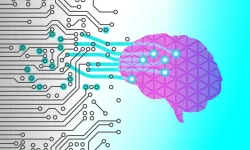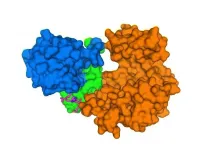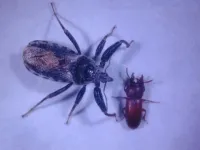(Press-News.org) Scientists have observed for the first time what it looks like in the key memory region of the brain when a mistake is made during a memory trial. The findings have implications for Alzheimer's disease research and advancements in memory storage and enhancement, with a discovery that also provides a view into differences between the physiological events in the brain during a correct memory versus a faulty one.
The study was published today in the journal Nature Communications.
In both correct and incorrect recall of a spatial memory, researchers could observe patterns of cell activation in the brain that were similar, though the pace of activation differed.
"We could see the memories activating," said Laura Colgin, an associate professor of neuroscience at The University of Texas at Austin and lead author of the paper. "It's like dominoes falling. One cell activates and then the next fires."
Colgin and her team used electrophysiological recordings of rats in and out of mazes to study signals in the brain as the rats attempted to remember where a food reward was located and find it.
When rats remembered where the food reward was and located it, a specific pattern of brain cells activated with similar timing. These cells, called place cells, are associated with memories involving spatial relationships and locations and are found in the hippocampus, a section of the brain where animals including humans store most of their memories. It is also a region of the brain that experiences degeneration in patients with Alzheimer's and related memory disorders.
"If we understand what happens when a memory is not properly retrieved, it may give us insights into what is happening with memory disorders like Alzheimer's," Colgin said.
What the researchers saw in rats when they got the location wrong surprised them. They expected to see cells fire in a jumble. What they saw was the same pattern observed when rats were correct in finding the location, but the timing of the cell activation was different.
"The activation started later and it was slower, but the same pattern fired," Colgin said. "There may be less energy in the network to drive the cells, and that may be why memory was not connected with action."
The study also found that on trials when rats remembered the correct location, they were accessing the memory of the location while they were resting between tests, causing the pattern of cells to activate as they waited, the way a person might practice a speech before giving it.
On trials when rats made mistakes, they did not activate the memory of the location before they entered the maze.
One of the lab's long-term goals is to contribute to understanding memory formation and retrieval enough that one day, lost memories could be accessed even by people with memory disorders with the help of brain-computer interface technology.
"If we can understand how these large ensembles of neurons that represent memories are formed and what's happening when these memories are being properly retrieved, someday we may be able to decipher and store memories," Colgin said.
Colgin and her team plan to continue the research and hope to be able to decode memory formation and activation in real time in rats.
INFORMATION:
Chenguang Zheng (now a faculty member at Tianjin University in China), Ernie Hwaun (now a postdoctoral researcher at Stanford University) and Carlos A. Loza at UT Austin also contributed to the research. Support for Colgin's research came from the National Institutes of Health and the National Science Foundation.
SAN RAMON, Calif., June 8, 2021--CooperVision today announced its scientific research program for the 2021 British Contact Lens Association Virtual Clinical Conference and Exhibition, which begins Sunday, June 13. For the first time, the biennial event will be streamed live over the course of 30 hours, welcoming members of the global eye care community to experience and discuss the latest category advancements.
More than 20 CooperVision-authored and sponsored investigations were accepted by the conference committee. The papers and posters span a range of topics that underpin the contact lens industry's evolution, including new data and insights on the complex lifestyle factors involved with addressing presbyopia, misperceptions surrounding soft toric lens fitting, ...
An unprecedented analysis of almost 10,000 Harmful Algal Bloom (HAB) events worldwide over the past 33 years was launched today by UNESCO's Intergovernmental Oceanographic Commission.
The first-ever global statistical analysis examined ~9,500 HABs events over 33 years and found that the harm caused by HABs rises in step with growth of the aquaculture industry and marine exploitation and calls for more research on linkages.
Conducted over seven years by 109 scientists in 35 countries, the study found that reported HAB events have increased in some regions and decreased or held steady in others. ...
UPTON, NY--Scientists at the U.S. Department of Energy's (DOE) Brookhaven National Laboratory have published the first detailed atomic-level model of the SARS-CoV-2 "envelope" protein bound to a human protein essential for maintaining the lining of the lungs. The model showing how the two proteins interact, just published in the journal Nature Communications, helps explain how the virus could cause extensive lung damage and escape the lungs to infect other organs in especially vulnerable COVID-19 patients. The findings may speed the search for drugs to block the most severe effects of the disease.
"By obtaining atomic-level details of the protein interactions we can explain why the damage occurs, and search for inhibitors ...
Natural selection can reverse evolution that occurs through sexual selection and this can lead to better females, new research shows.
The study - led by the University of Exeter and Okayama University - examined broad-horned flour beetles, whose males have exaggerated mandibles, while females do not.
Male beetles with the largest mandibles win more fights and mate with more females - an example of "sexual selection", where certain characteristics (like a male peacock's tail) improve mating success.
However, having bigger mandibles requires a masculinised body (large head and neck), ...
Women who will develop potentially life-threatening disorders during pregnancy can be identified early when hormone levels in the placenta are tested, a new study has shown.
Pregnancy disorders affect around one in ten pregnant women. Nearly all of the organ systems of the mother's body need to alter their function during pregnancy so that the baby can grow. If the mother's body cannot properly adapt to the growing baby this leads to major and common issues including fetal growth restriction, fetal over-growth, gestational diabetes, and preeclampsia - a life-threatening high blood pressure ...
New research has shown that by injecting an alkalinizing agent into the ocean along the length of the Great Barrier Reef, it would be possible, at the present rate of anthropogenic carbon emissions, to offset ten years' worth of ocean acidification.
The research, by CSIRO Oceans and Atmosphere, Hobart, used a high-resolution model developed for the Great Barrier Reef region to study the impact of artificial ocean alkalinization on the acidity of the waters in the Great Barrier Reef. The study is based on the use of existing shipping infrastructure to inject a source of alkalinity into the ocean, which could also be considered as an acceleration of the chemical weathering of minerals through natural ...
Researchers from the Hong Kong University of Science and Technology (HKUST) and Beijing Tiantan Hospital have recently uncovered a new gene mutation responsible for the non-familial patients of cerebral cavernous malformation (CCM) - a brain vascular disorder which inflicted about 10~30 million people in the world.
While the mutation of three genes: namely CCM1, CCM2, and CCM3, were known to be a cause of CCM - they mostly targeted patients who has family history in this disorder - which only account for about 20 per cent of the total inflicted ...
Philadelphia, June 8, 2021 - When shopping online, participants surveyed spent more money, purchased more items, and spent less on candy and desserts than when they shopped in-store, according to a END ...
BINGHAMTON, N.Y. -- New research from Binghamton University, State University of New York shows the human trauma and family separation that resulted from the Trump Administration's zero tolerance policy on undocumented immigration.
The news reports surrounding the Trump Administration's "zero tolerance" policy on undocumented immigration were stark: children separated from their parents, uncertain whether they would ever see them again.
All told, the official zero tolerance policy lasted only a few months, from April to June 2018. But family separations occurred before and after those dates: at least 5,512 children were separated from their families since July 2017, and 1,142 families were separated ...
Anyone who collects mushrooms knows that it is better to keep the poisonous and the non-poisonous ones apart. Not to mention what would happen if someone ate the poisonous ones. In such "classification problems", which require us to distinguish certain objects from one another and to assign the objects we are looking for to certain classes by means of characteristics, computers can already provide useful support to humans.
Intelligent machine learning methods can recognise patterns or objects and automatically pick them out of data sets. For example, they could pick out those pictures from a photo database that show non-toxic ...





